I Used to Be a Television Star 🔗
In 1987, I decided to make a television show.There were a few problems. For one, I was in middle school, and barely a teenager. My voice hadn't even changed yet.
I had no video equipment. No set. No actors. No crew. No budget. No experience.
But I was industrious, and determined.
Clarksville Middle School had just started a program called TRIAD. It provided the framework for students to explore unconventional methods of learning. Or something like that. I remember going to Mr. Paulis, the TRIAD advisor, and explaining that I would like to make a weekly television show.
"I see," he said. "What would it be about?" he asked, perhaps humoring me.
"Hmm," I demurred, scatching my chin. And then I said confidently and authoritatively: "Science."
"Uh-huh," said Mr. Paulis.
"And it will be called: Scientific Spotlight," I added.
I had always been a fan of 3-2-1 Contact, a science educational show that ran on PBS from 1980 to 1988. (Thanks, Wikipedia!) Besides covering science, which I loved, it also had a catchy theme song, which I knew was an important ingredient for any successful television show. So I decided I would make a show in the same mold.
"Weekly, huh?" asked Mr. Paulis. "Well, OK. You'll need to pick a topic, do lots of research, and write a script. Then we'll see about getting a video camera."
This was perhaps meant to dissuade me, but I took it as a greenlight and charged forward.
I sold several friends on the idea, including Brette Goldstein, Kalen Yang, and Jeff Lavis. Brette and Kalen agreed to be interviewers, and Jeff volunteered to be a cameraman.
Cast and crew was in place.
The topic was easy to choose: I had always been fascinated by lasers, and wanted to learn more about them. In the late 1980's, lasers were beginning to show up in all kinds of places. Supermarkets had started using them to scan groceries, and the expensive and newfangled compact disk player was gaining in popularity. The Stars Wars defense program, which was talked about breathlessly on the news, depended on powerful lasers that could blow up things. This was all certainly cool stuff. But how did they work, exactly?
 |
Opening shot from the television show. Notice the fancy titling. Lower case letters were invented subsequent to the taping of this segment. |
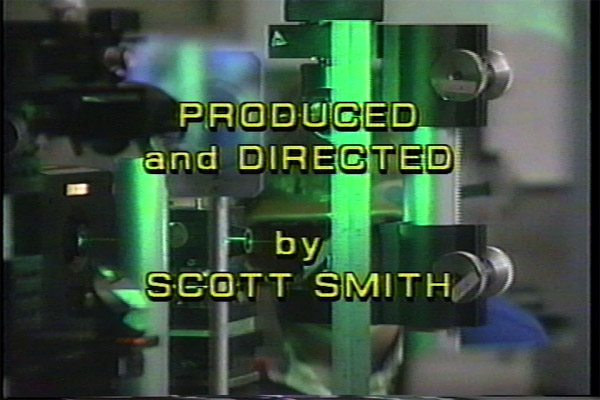 |
Hey, that’s me! (And that’s me hiding behind the laser, too.) |
So I began doing research. And with Mr. Paulis's help, I started chatting with laser experts throughout Maryland.
First up, Brette, Kalen, Jeff and myself visited Dr. Russ Poch, a physics professor at a local community college.
Dr. Poch knew all about lasers, and even owned a few. With cameras rolling (*), Dr. Poch explained to Brette and Kalen all about lasers; how gases are excited, how the type of gas determines the color of the laser, and how lasers can travel through air or fiber optics.
(*): OK, there was one camera. But doesn't it read better plural?
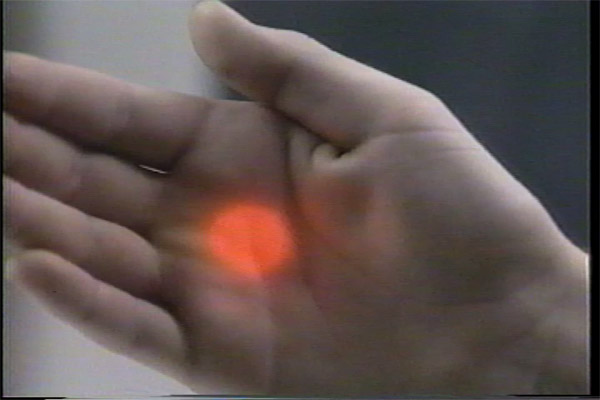 |
Here I demonstrate my excellent hand modeling skills by reflecting a bright laser beam off my palm. There was no CGI involved here, folks — that is an *actual* laser hitting my *actual* hand! The things I do for science. |
Jeff did a great job videotaping the segment, but we discovered the the camera's zoom motor was significantly louder than, say, Dr. Russ Poch. We also discovered that the camera didn't really pick up laser light all that well. The resulting footage was, thus, "challenging."
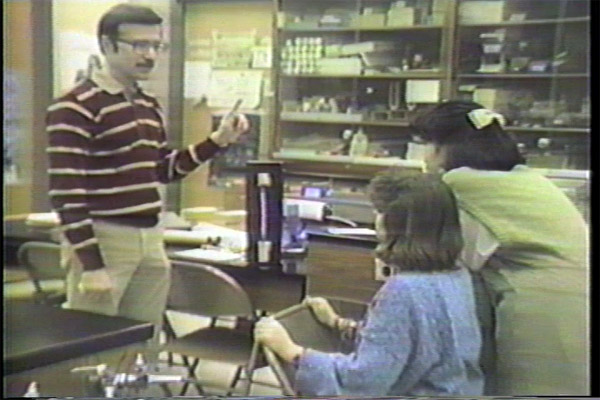 |
Dr. Russ Poch, left, explains how excited argon gas glows purple to Brette Goldstein and Kalen Yang. |
Clearly, we would have to refine our techniques for capturing lasers on video. But first, there was an important field trip to make.
I decided I must visit a grocery store to find out, firsthand, how lasers are used to scan groceries.
Even better, I was authorized to take a day off from school to make this field trip. The TRIAD program rocked!
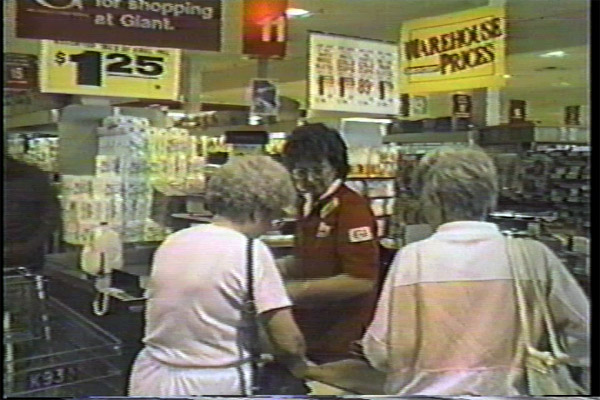 |
This engaging footage from Scientific Spotlight shows the excitement of a grocery store during school hours. |
Ah, but there was a problem. The morning I was scheduled to visit Giant, a local supermarket, I woke up with a bad fever. I was too sick to go to school, and even too sick to go to the supermarket. I have never been so dissapointed about not being able to go to the supermarket.
But a second problem cancelled out this problem. The visit to the supermarket had been arranged by Mr. Stout. He was a history teacher at my middle school, but also worked part-time at the local Giant.
But Giant corporate had learned about this visit, and made it clear that video crews weren't permitted to visit a store without corporate blessing and "handling." And we did not have corporate blessing.
Mr. Paulis leapt into action, smoothing things over with corporate (who can turn down a kid trying to learn about science?), and before long we were visiting Giant and learning all about their scanning lasers and how all products across all of their stores are stored in a centralized database with real-time inventory information (right down to the number of toilet paper rolls!). That was impressive stuff for the 80's, let me tell you.
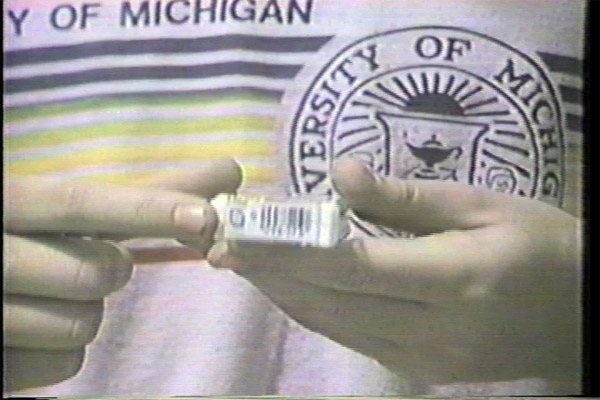 |
In this award-winning shot, I can be seen holding Tic Tacs at the supermarket. Notice my clever angling of the Tic Tacs such that the bar code is aimed strategically right at the camera. It took several takes and much practice to get this effect, which looks so effortless. |
So we grabbed some exciting footage of groceries being scanned.
Beep. Blip. Beep.
Really riveting footage.
Well, not so much. It was definitely time to raise the bar.
To do that, Mr. Paulis made some contacts at the Johns Hopkins University Applied Physics Lab, or APL.
APL was definitely a place of science. It had all kinds of labs with expensive laboratory equipment and people walking around in lab coats -- perfect! And they had tons of lasers, which they were using for all sorts of interesting purposes.
Even better, they had a fancy video camera that was designed to capture laser light. And they offered to let us use it.
So off to APL we went.
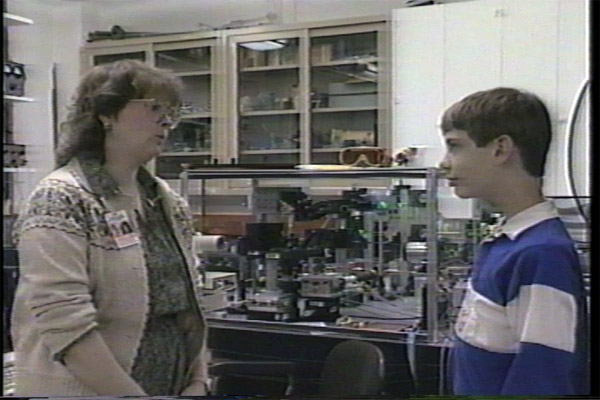 |
I interview Dr. Jane Maclachlan of the Applied Physics Laboratory. For this important interview, I am wearing a Coca-Cola shirt. They were all the rage that year in middle school, sandwiched between Garbage Pail Kids and Swatch watches. Even then I had an uncanny sense of style. I, um, also had braces. |
I started by interviewing Dr. Jane Maclachlan. She explained how they were developing technology to use lasers to scan surfaces such as airplane wings, looking for hairline fractures that could not otherwise be detected.
During the interview, I was careful to say "um" every few words in my questions, to keep things informal and comfortable.
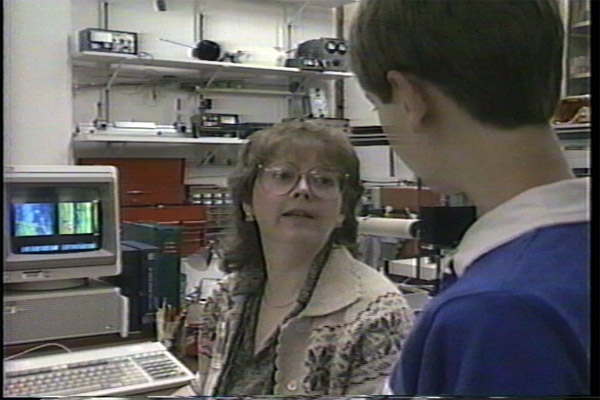 |
Check out the fancy camera angles. Scientific Spotlight cut no corners! |
Next up, I interviewed Mr. Ron Zariello, also of APL. He had some really powerful lasers. They could burn through things. I insisted on a demonstration. The laser was so bright we had to leave the room.
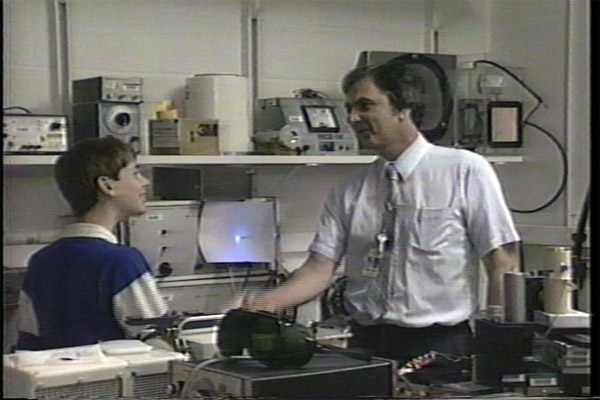 |
After dispensing with formalities, I insisted that Mr. Zariello use his lasers to destroy something. For science. |
By now, I had a lot of great footage, and had certainly learned a lot about lasers and the corporate diplomacy required to bring video cameras into places of business. I wrote a final script that weaved together everything, and spent time in a professional studio editing everything together. To begin, I had to narrate the script into a microphone. This was a time consuming process, because I kept messing up.
Once the audio track was laid down, it was simply a matter of painting video on top of it. During some sections, I discovered there was no good video. For example, I had no video of Star Wars satellites using lasers to blast away missiles. So, I used my unparalleled artistic talents to produce a five-frame animation showing Star Wars in all its glory.
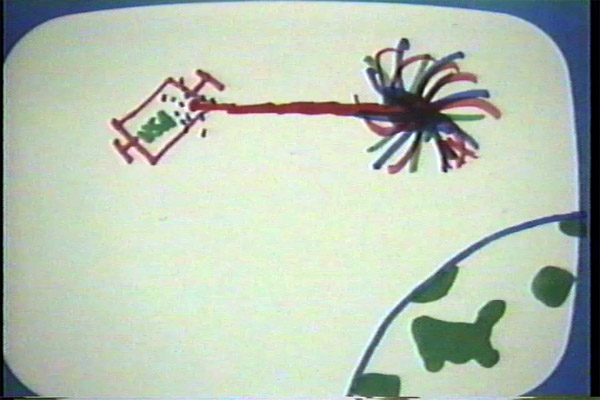 |
A frame of my animation showing Star Wars in action. The sophisticated animation technologies I invented for this scene went on to power popular Pixar movies such as Toy Story. Note, also, that the United States appears to be surrounded by water. Mexico and Canada apparently were not invented until high school. |
Finally, the first episode of Scientific Spotlight was in the can.
It only took 9 months of effort to produce. A weekly series, clearly, was a bit too ambitious, especially when I had other responsibilities, such as Writing class, Physical Education, Algebra, and Home Economics. (Those responsibilities had reclaimed Brette, Kalen, and Jeff shortly after the initial taping. I am not sure where Kalen and Jeff are today, but Brette is now a big-time casting director in New York City.)
But, even though it embarrasses me greatly to watch Scientific Spotlight today, the final result was very professional and engaging.
So much so, that schools in my county insisted on showing it to incoming students at the beginning of each school year.
For many, many years to come.
All the way through high school and even into college, I would often be stopped in my home town by people who would say "hey! Aren't you the laser guy?"
Denise Koch, a long-time anchor at WJZ-TV in Baltimore, even visited my middle school to interview me about Scientific Spotlight. She was so impressed that she invited us to visit WJZ studios. That was really eye-opening; I learned about blue screen technology for the first time, and I've always looked at weathermen suspiciously ever since. Who do they think they're trying to fool, pretending to look at weather maps that aren't there?
I was always very grateful to all the people who helped make Scientific Spotlight happen. They didn't need to help out a little kid, but they jumped over themselves to lend a hand, just the same. I was able to repay Mr. Paulis in some way, by nominating and writing him up for the prestigious Howard County "Teacher of the Year" award. He won, and I remember the beaming smile on his face when he accepted the award.

